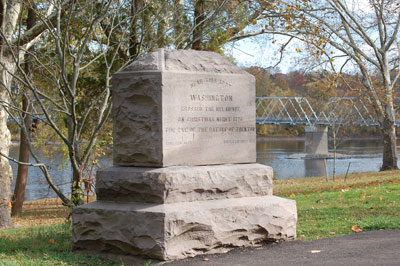The Park
 In the late 1800s, Americans began to acknowledge the country’s historic events and sites with greater interest. The United States Centennial Exposition, held in Philadelphia’s Fairmount Park in 1876, played a large role in fostering a new appreciation of the nation’s past.
In the late 1800s, Americans began to acknowledge the country’s historic events and sites with greater interest. The United States Centennial Exposition, held in Philadelphia’s Fairmount Park in 1876, played a large role in fostering a new appreciation of the nation’s past.
Often, local groups led the way in these efforts. This was the case in Bucks County, where in 1895 the Bucks County Historical Society placed a stone marker at the spot from which Washington’s army launched its daring Christmas night 1776 crossing of the Delaware River.
In 1917 – urged on by the Bucks County Historical Society, the Daughters of the American Revolution, the Patriotic Order of the Sons of America, and the Historical Society of Pennsylvania – the Commonwealth of Pennsylvania created the Washington Crossing Park Commission. The park was established that year, and in 1918, the name of the Taylorsville post office was changed to Washington Crossing.
Today the 500-acre park is managed by the Pennsylvania Department of Conservation and Natural Resources and operated through partnership with The Friends of Washington Crossing Park. Each year the park hosts thousands of visitors, from local schoolchildren to visitors from around the world, who come to see the point from which a battered and dispirited American army launched a counterattack that reversed its long losing streak, preserving its will to fight and maintaining the revolutionary spirit that would lead to independence for the United States.
But Washington Crossing Historic Park represents much more than a single event. Restored Colonial buildings in the park, such as the Thompson-Neely House and McConkey Ferry Inn, give many clues about living conditions during the Revolutionary era. Later, homes and shops reveal how 19th-century rural Pennsylvanians lived and worked. Among them are the home of a prosperous merchant, a village general store, and homes for skilled artisans. The park also contains Bowman’s Hill Tower, Revolutionary War soldiers’ graves, stone memorials, picnic pavilions and historic collections.

